Teachers Toolkit Blog

Encourage Critical Thinking with Puzzles, Games, and Activities
Resources · Thematic · Thinking Skills
Critical thinking is a necessary skill that all students need. Even students as young as kindergarten or first grade can start to learn this skill. Encourage critical thinking with fun, engaging activities that make your students think! To see more tips on teaching critical thinking, check out my earlier blog post.

how to encourage critical thinking
Critical thinking is being able to see and understand the logical connections between ideas, identify inconsistencies, and solve problems. This might seem like a tall order for our littlest students. There are activities that will encourage critical thinking while still keeping the learning fun.
- Fill in the Gaps – this activity requires students to use evidence and prior knowledge. Project a picture on the board. Then at the top of a piece of paper, students will write “What is happening in this picture?” At the bottom of the page, they can write their answer. In the middle of the paper, students should write down the evidence they see in the picture that led them to their answer.
- Build It – do this flexible team-building activity at any age level. Give the teams some simple building materials in equal amounts, such as pipe cleaners, gum drops, marshmallows, spaghetti, blocks, etc. Then give them something specific to construct with the materials. In addition to critical thinking skills, students will practice teamwork and collaboration.
- Open-Ended Questions – Read a story to your students and ask them questions that can’t be answered with a simple one or two-word answer. First, ask them to predict what will happen next or at the end of the story. Next, practice inference with questions that are not explicitly answered in the story. For example, show them a page in the story that shows the sun shining with leafy trees and ask what time of year it is. Third, have students tell you what the story is about in one sentence. This is a great way for them to start thinking about the main ideas of stories.
higher-order thinking with games and puzzles
Playing games and solving puzzles are fun ways to encourage critical thinking skills. Math puzzles, mazes, and jigsaw puzzles all require students to use higher-order thinking.
It’s fairly easy to incorporate this skill into your everyday teaching. Bellwork is a perfect time! I’ve created Critical Thinking Activities Task Cards for quick ways to let your students practice different types of critical thinking.
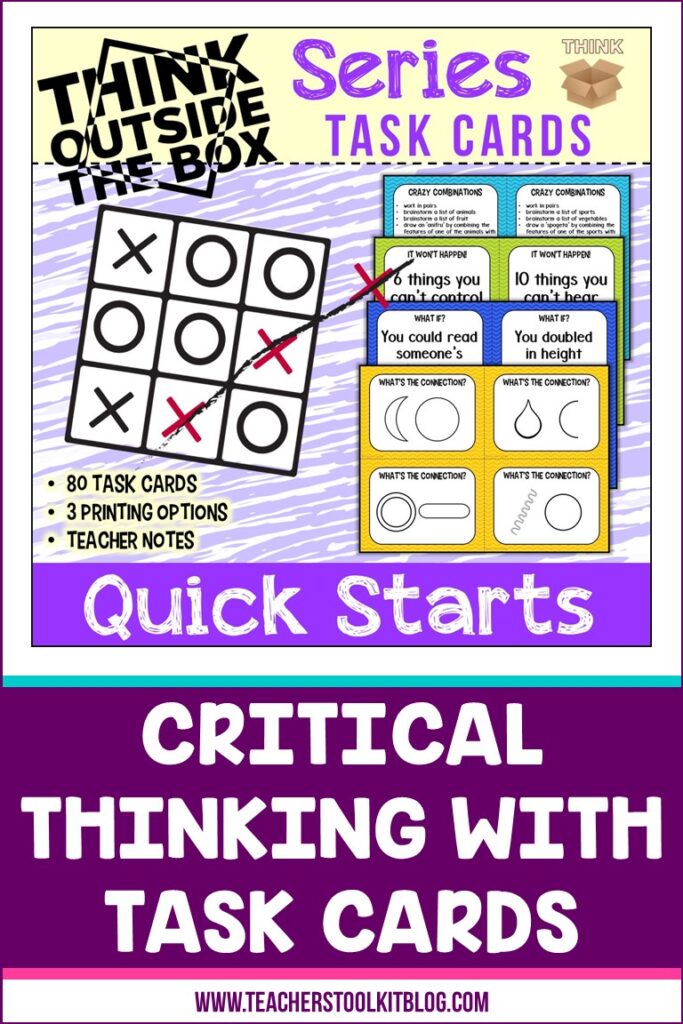
These Critical Thinking Activities Task Cards provide teachers with activities and puzzles to help students develop critical thinking skills . In this pack, you will find 80 quick start task cards – 4 cards per page. Your elementary students will love trying to figure out the puzzle or challenge and you will love knowing that they are using higher order thinking skills!
These ‘quick starts’ are ideal warm-up activities for the beginning of a lesson. Use them flexibly in any order, at any time. I would suggest laminating them for durability.
Today’s students are the problem-solvers of the future. If they are taught factual knowledge only, they tend to respond with conventionally correct answers rather than exploring creative solutions. All students can learn to think critically and creatively.
See my other resources for critical thinking:
- Think Outside of the Box Series: Surprising Shapes
- Thinking Skills Think Outside of the Box Series: Activities
- Thinking Skills Think Outside of the Box Series: Bundle
Related posts:
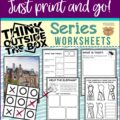
- Privacy Policy
- VIP Resource Library
- Cookie Policy (EU)

Addition (Basic)
Addition (Multi-Digit)
Algebra & Pre-Algebra
Comparing Numbers
Daily Math Review (Math Buzz)
Division (Basic)
Division (Long Division)
Hundreds Charts
Measurement
Multiplication (Basic)
Multiplication (Multi-Digit)
Order of Operations
Place Value
Probability
Skip Counting
Subtraction
Telling Time
Word Problems (Daily)
More Math Worksheets
Reading Comprehension
Reading Comprehension Gr. 1
Reading Comprehension Gr. 2
Reading Comprehension Gr. 3
Reading Comprehension Gr. 4
Reading Comprehension Gr. 5
Reading Comprehension Gr. 6
Reading & Writing
Reading Worksheets
Cause & Effect
Daily ELA Review (ELA Buzz)
Fact & Opinion
Fix the Sentences
Graphic Organizers
Synonyms & Antonyms
Writing Prompts
Writing Story Pictures
Writing Worksheets
More ELA Worksheets
Consonant Sounds
Vowel Sounds
Consonant Blends
Consonant Digraphs
Word Families
More Phonics Worksheets
Early Literacy
Build Sentences
Sight Word Units
Sight Words (Individual)
More Early Literacy
Punctuation
Subjects and Predicates
More Grammar Worksheets
Spelling Lists
Spelling Grade 1
Spelling Grade 2
Spelling Grade 3
Spelling Grade 4
Spelling Grade 5
Spelling Grade 6
More Spelling Worksheets
Chapter Books
Charlotte's Web
Magic Tree House #1
Boxcar Children
More Literacy Units
Animal (Vertebrate) Groups
Butterfly Life Cycle
Electricity
Matter (Solid, Liquid, Gas)
Simple Machines
Space - Solar System
More Science Worksheets
Social Studies
Maps (Geography)
Maps (Map Skills)
More Social Studies
Art & Music Printables
Colors Worksheets
Coloring Pages
Learn to Draw
Music Worksheets
More Art & Music
Thanksgiving Worksheets
Winter Worksheets
Christmas Worksheets
Hanukkah Worksheets
More Holiday Worksheets
Puzzles & Brain Teasers
Brain Teasers
Logic: Addition Squares
Mystery Graph Pictures
Number Detective
Lost in the USA
More Thinking Puzzles
Teacher Helpers
Teaching Tools
Award Certificates
More Teacher Helpers
Pre-K and Kindergarten
Alphabet (ABCs)
Numbers and Counting
Shapes (Basic)
More Kindergarten
Worksheet Generator
Word Search Generator
Multiple Choice Generator
Fill-in-the-Blanks Generator
More Generator Tools
Full Website Index
Puzzles and Brain Teasers - Full List

Build logical thinking skills with these addition square puzzles.
Challenge students with these mind-bending, critical thinking puzzles.
Assemble a cipher disk and use it to decode facts about animals, explorers, plants, and other science/social studies topics.
Students love to learn with these foldable origami cootie catcher (aka Fortune Teller) games.
This page has a nice selection of "connect the dots" puzzles. These are great for reviewing basic counting, alphabet, roman numerals, and skip counting.
Look carefully for items hidden within the playful scenes.
Build vocabulary and critical thinking skills with these analogy worksheets.
Penelope Peabody is lost somewhere in the USA. Can you tell where she is? Use the 50 states worksheet puzzles on a daily or weekly basis.
First find the answers to the math problems and plug the answers into the puzzles.
To find the answer to a funny riddle, solve the math problems. Skills include division, multiplication, subtraction, addition, place value, roman numerals, and many more.
Plot the ordered pairs on the coordinate grid and connect the points to reveal mystery pictures.
Solve the subtraction, addition, division, and multiplication facts to reveal a mystery picture.
The teacher posts a clue each day of the week. Students read the clues and try to figure out the mystery number.
Kids love these math puzzle match games! Try them in your learning centers. Topics include addition, subtraction, multiplication, division, time, money and more!
Learn Sudoku with these easy, fun puzzles.
Challenge your students with these printable tangram puzzles. These worksheets are made specially for your 4-inch classroom tangram sets. Basic and advanced levels available.
Weekly "What Am I?" challenge puzzles for kids of all ages.
Students change one letter in each word on the puzzle to make a new word. These are great for teaching phonics, vocabulary, and critical thinking.
Connect the letters in these maze puzzles to make words from the list. Then find a science fact written in the unused letters.
We have lots of non-holiday word search puzzles for students of all ages.
A full index of all Math, ELA, Spelling, Phonics, Grammar, Science, and Social Studies worksheets found on this website.
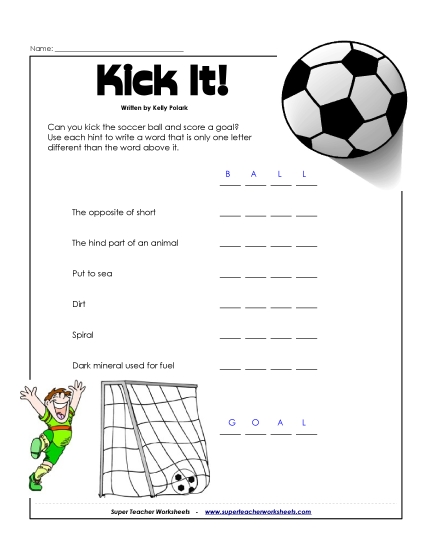
Puzzles and brainteasers are excellent tools for enhancing learning in elementary school English Language Arts (ELA), as they engage students in fun, interactive ways while sharpening critical thinking, problem-solving, and language skills. Word-based puzzles like word ladders, word searches, and crossword puzzles help students expand their vocabulary, improve spelling, and develop pattern recognition. For example, word ladders require students to change one letter at a time to create new words, fostering an understanding of phonics and spelling rules. Word searches, on the other hand, help students recognize letter patterns and enhance visual scanning skills, both of which contribute to improved reading fluency.
Beyond word puzzles, brainteasers like hidden pictures, tangrams, and mazes stimulate cognitive development by encouraging students to think critically and strategically. Activities like Sudoku and logic puzzles help students develop reasoning skills, which are key to solving complex problems not only in math but also in reading comprehension and writing. These puzzles require students to look for patterns and relationships, helping them develop a deeper understanding of how things connect—skills that are directly transferable to understanding sentence structure and narrative flow in ELA. Tangrams and hidden picture activities also promote spatial reasoning, which is useful for understanding directions and visualizing story elements.
Incorporating puzzles and brainteasers into the classroom provides a fun, low-pressure way for students to practice essential academic skills. Teachers can use the activities that Super Teacher Worksheets provides as warm-ups, transitions, or enrichment exercises, giving students the opportunity to challenge themselves while also building skills in language arts and beyond. Additionally, puzzles promote perseverance, creativity, and concentration, teaching students the value of patience and persistence when working through difficult tasks. By sharpening both their language and critical thinking skills, students develop the cognitive tools necessary for academic success across subjects.

- Skip to primary navigation
- Skip to main content
- Skip to primary sidebar
Teaching Expertise
- Classroom Ideas
- Teacher’s Life
- Deals & Shopping
- Privacy Policy
20 Critical Thinking Activities For Elementary Classrooms: Navigating Fact And Fiction (+Resources)
December 1, 2023 // by Seda Unlucay
With the barrage of mainstream news, advertising, and social media content out there, it’s vital for students to think independently and learn to differentiate between fact and fiction.
This series of critical thinking activities, STEM-based design challenges, engaging Math puzzles, and problem-solving tasks will support students in thinking rationally and understanding the logical connection between concepts.
1. Teach Students How to Obtain Verifiable News
There’s probably no 21st-century skill more important than differentiating between real and fake sources of news. This editable PowerPoint bundle covers traditional media, social networks, and various target audiences and teaches students how to find verifiable facts.
Learn More: Teachers Pay Teachers
2. Watch and Discuss a Critical Reasoning Video
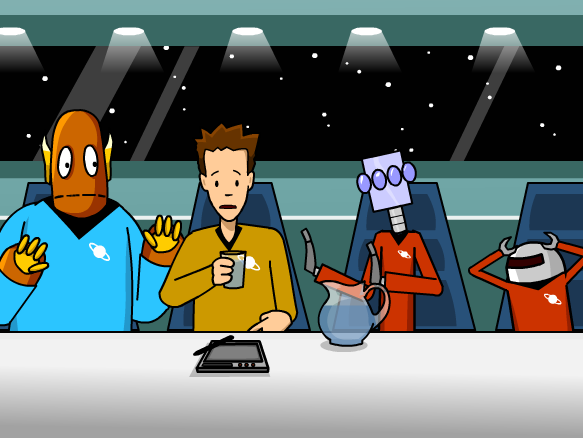
This kid-friendly video teaches students to break arguments down into claims, evidence, and reasoning. Armed with this lifelong learning tool, they will be able to make more informed decisions when consuming all types of information.
Learn More: Brain Pop
3. Complete a Critical Design Challenge
This science and designed-based classroom activity challenges students to find ways to prevent a falling egg from breaking. Pairing it with the classic Humpty Dumpty nursery rhyme is sure to inspire many creative ideas.
Learn More: Education
4. Critical Community Engagement Activity
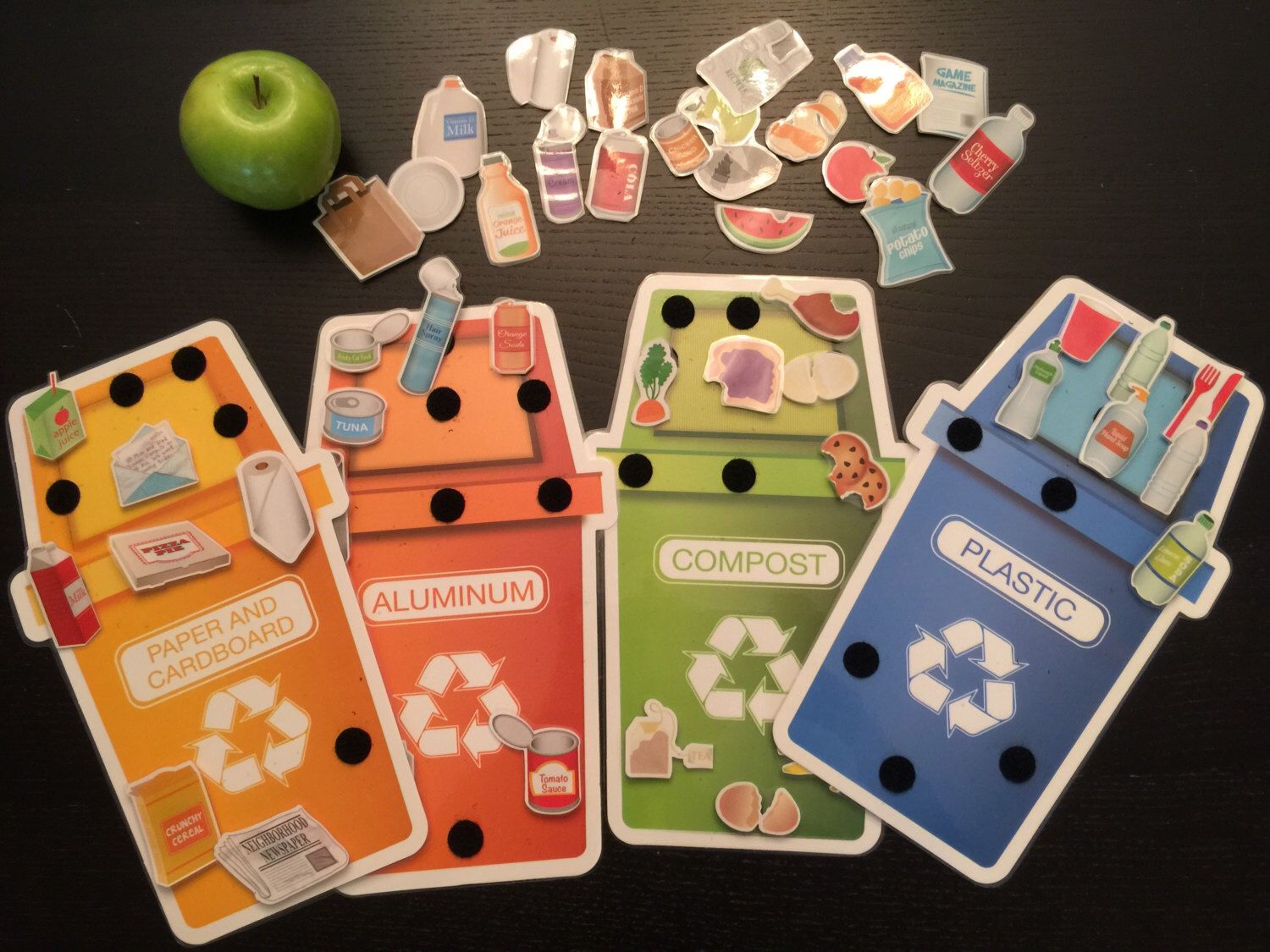
This community engagement activity requires analytical skills to determine what items can be recycled in the classroom and in their neighborhood. By creating recycling bins from reusable cardboard boxes, students have an opportunity to contribute to the environmental well-being of their community while practicing social responsibility.
Learn More: Kaboom
5. Develop Logical Skills with a Then and Now Activity
We may no longer use candles for reading or quill pens for writing, but can your students identify the objects that have replaced them? This activity engages their writing, drawing, and logical skills while giving them a chance to reflect on all the changes in our modern world.
Learn More: Education
6. Play a Critical Thinking Game
This active learning activity requires students to use their critical thinking skills to make comparisons and create meaningful analogies. The fun animal safari theme is sure to inspire many funny and creative ideas!
7. Develop Social-Emotional Problem-Solving Skills
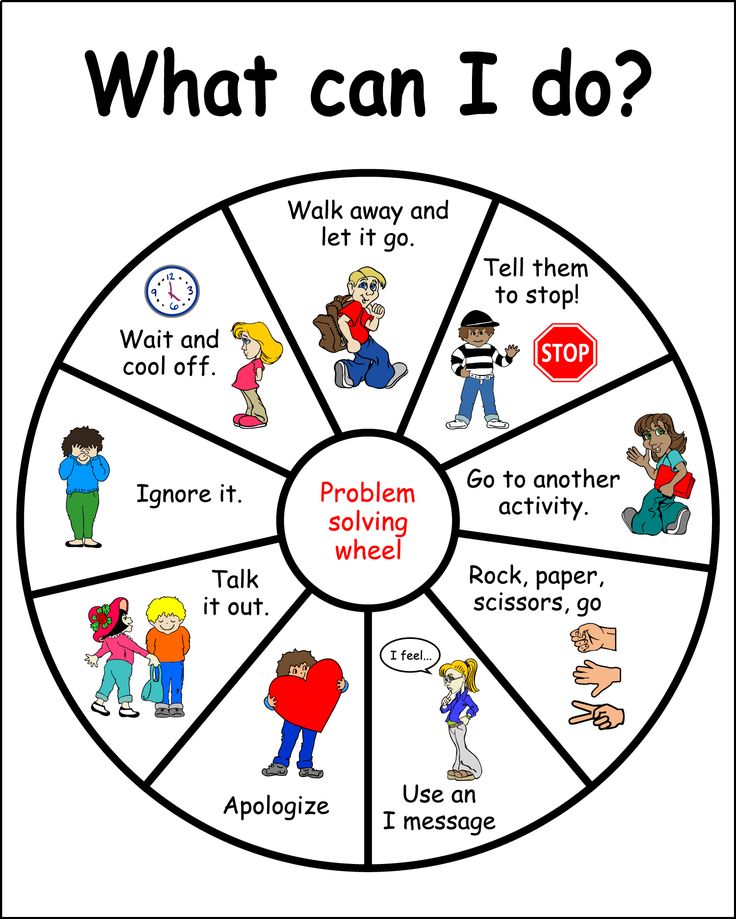
Through this lesson, students will understand that while conflicts are a normal part of life, it’s vital to have problem-solving skills to resolve them. This is also an excellent opportunity for developing their social awareness and relationship skills.
Learn More: ED Foundations

8. Desert Island Survival Game

This classic game is sure to inspire student engagement, as they use their critical thinking skills to survive being stranded on a desert island. Students have to watch out for ideological assumptions and question ideas in order to determine the appropriate items to bring.
9. Play a Problem-Solving Treasure Hunt Game
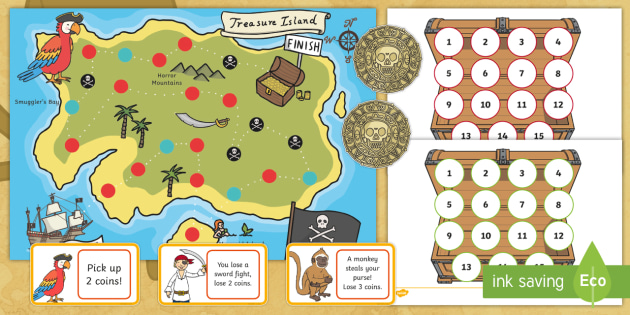
This exciting game for kids requires them to use key math skills to break a series of codes. With ample time, designated progress monitors, and sharp critical thinking skills, students are sure to find the hidden treasure.
Learn More: Twinkl
10. Use Writing to Increase Critical Empathy

This activity builds writing fluency while giving students a chance to show appreciation for each other. As they reflect emphatically on their classmates’ contributions and character, their base level of kindness and sense of ethical responsibility is bound to increase.
Learn More: Edutopia
11. Learn How to Make Logical Inferences
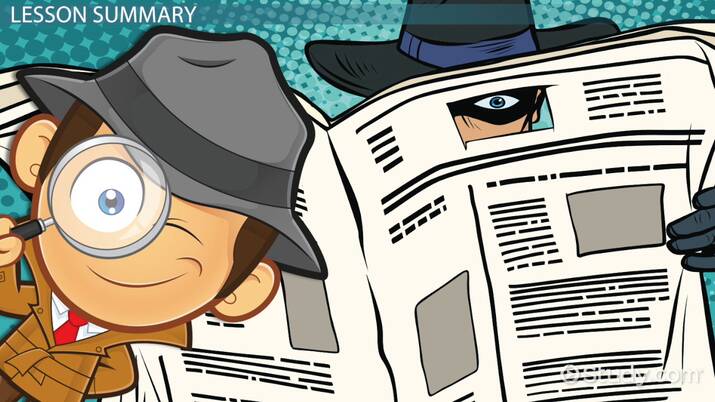
This activity for kids teaches the critical academic skill of making inferences from a series of texts. Students will surely enjoy playing the role of detective in order to draw their own logical conclusions.
Learn More: Study
12. Think Critically About Cultural Assumptions

This engaging activity for students challenges them to think critically about why people from a variety of cultures decorate their bodies. It helps them to break through cultural assumptions while comparing and contrasting the different forms of hand and body painting around the world.
Learn More: Harmony
13. Big Paper Silent Reflection Activity
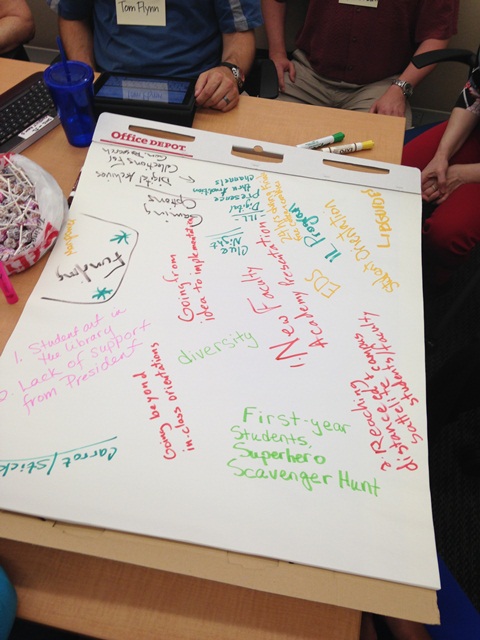
After posing some open-ended questions, students silently write their responses with colored markers on large chart paper. After each group has circulated around the room, students can share their critical reflections and learn from the various perspectives of their classmates.
Learn More: Slideshare
14. Watch a TED Video About the Socratic Method
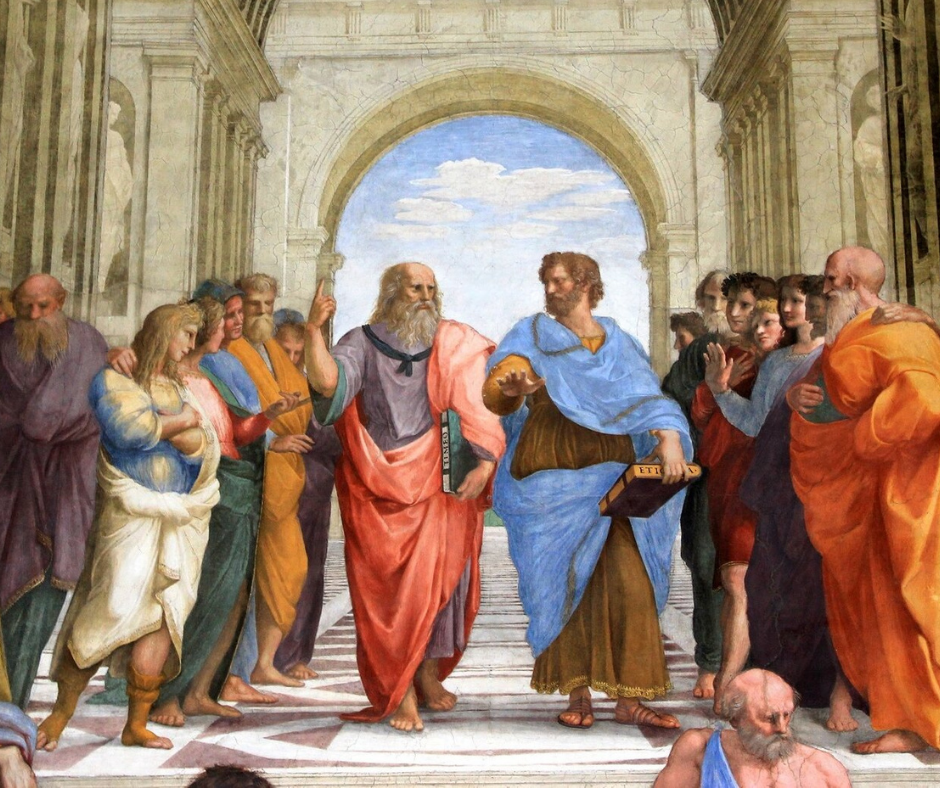
Socrates is one of the forefathers of critical thinking, who focused on making his students thinking visible by questioning their logic and reasoning. The accompanying quiz and discussion questions are an excellent way to reinforce student learning.
Learn More: Ted Ed
15. Brainstorm Ways to Help a Homeless Person

This lesson in civic responsibility teaches students about the causes of homelessness and guides them to find ways to help the homeless in their communities. It develops key problem-solving skills while building critical empathy.
Learn More: National Homeless.org
16. Guess the Object Game
This video features a series of twenty zoomed-in mystery objects. Students will love using their critical thinking skills to guess each one!
Learn More: Andy – The ESL Guy
17. Solve Some Challenging Math Brain Teasers
This abundant series of brain teasers is the perfect choice if you’re looking to test your children’s memory and problem-solving skills. Encourage them to use their knowledge of numbers to complete these tricky math problems that are not only designed to challenge your little brainiacs but are also compiled in an easy-to-use format.
Learn More: Mental Up
18. Complete a STEM Elevator Challenge
In this design and engineering-based lesson, students have to build a functional elevator that can carry an object to the top of a structure. It’s a terrific way to encourage cooperative learning while sharpening their problem-solving skills.
Learn More: Georgia Youth Science and Technology Centers
19. Create the Perfect Farm
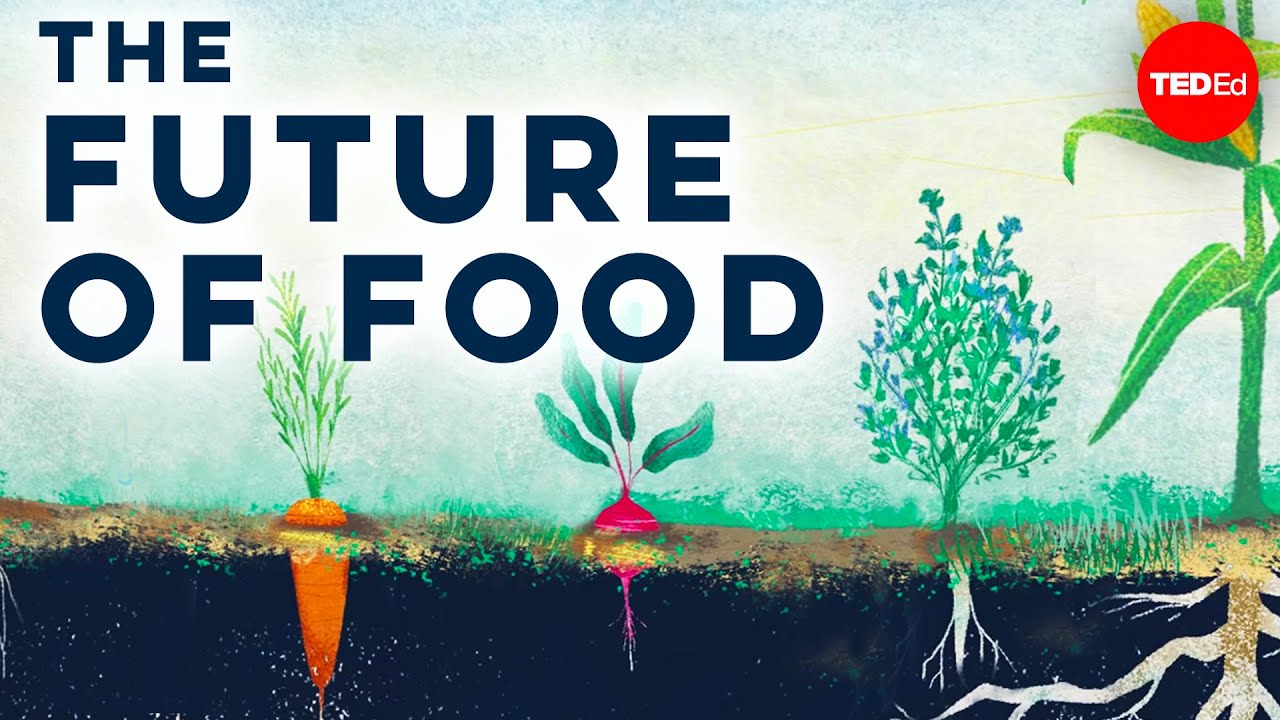
There’s no better way to develop critical thinking skills than by solving real-world problems. This video encourages students to think about ways to feed a growing global population in an environmentally sustainable way.
20. Solve Logic Grid Puzzles
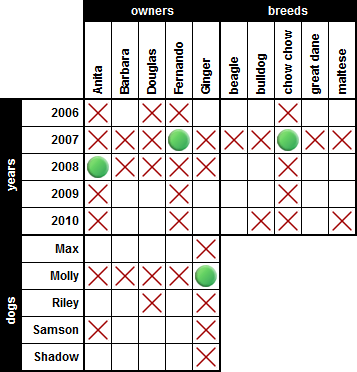
These logic grid puzzles will motivate students to use logical reasoning skills and the process of elimination to solve a series of clues. But be warned, they are highly addictive and difficult to put down once you get started!
Learn More: Puzzle Baron’s Logic Puzzles
Social-Emotional Learning Resources
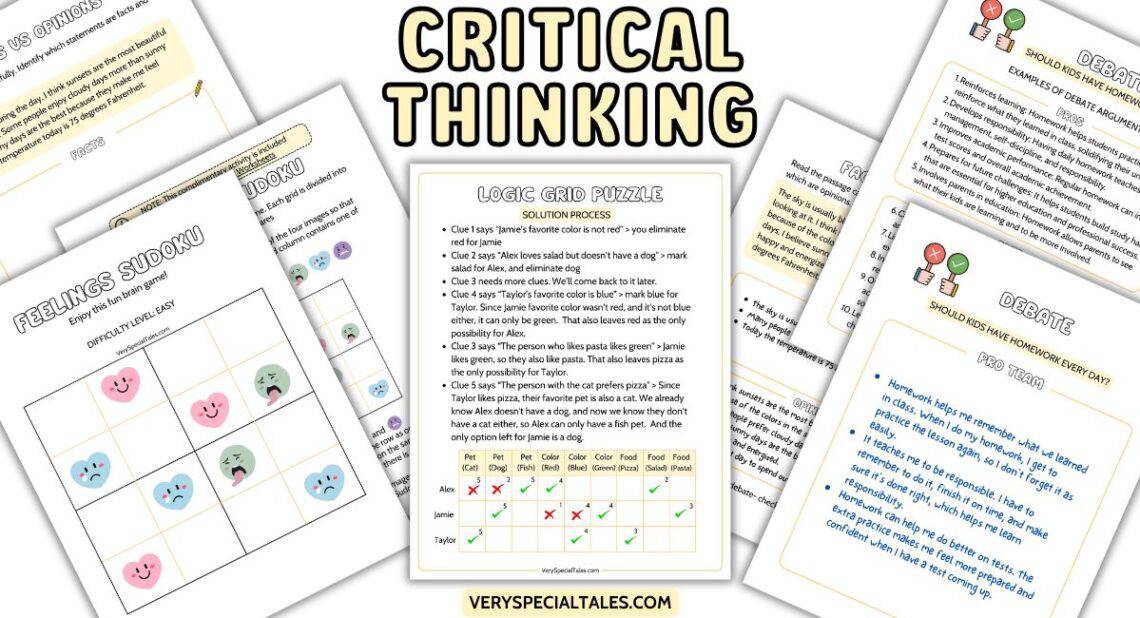
36 Fun Critical Thinking Games and Activities for Kids (Printable)
Critical Thinking Games & Activities for Kids: Critical thinking skills are widely recognized as essential to equip children for learning, in and outside the classroom, and for modern life. In this post, we will explore what critical thinking means, why it is so important, and how to help build these skills in children with 36 fun critical thinking activities. You will also be able to download a free worksheet with some of the activities mentioned in the post.
Table of Contents
- What is critical thinking?
- Why are critical thinking skills important?
- How can we help build the skills and mindset for critical thinking?
- 36 Fun critical thinking activities for kids
- Critical thinking worksheets download
What is Critical Thinking?
We all know more or less what critical thinking is. So it may surprise you to know that there is no one standard, agreed definition. US philosopher and educator John Dewey first developed the concept in the early 20th century, although he more commonly used the term “reflective thinking”, defined as:
“Active, persistent, and careful consideration of any belief or supposed form of knowledge in the light of the grounds that support it and the further conclusions to which it tends.”
The Reboot Foundation provides a simpler, more contemporary definition:
“We define critical thinking broadly, and we believe it is a type of reflective thought that requires reasoning, logic, and analysis to make choices and understand problems.”
Most experts agree that there are two dimensions to critical thinking:
- Skills, or abilities which can be taught ( such as analysis, inference, evaluation, self-regulation).
- Dispositions, or attitudes, which can be developed ( such as being open-minded, fair-minded, suspending judgement, inquisitiveness).
Skills can be more straightforward to teach, and to measure, than dispositions. But critical thinking skills and dispositions are mutually reinforcing, and should be built together.
One way to explain how critical thinking differs from simply acquiring knowledge is through “Bloom’s Taxonomy”, developed in 1956, and revised to the version below in 2001. The Taxonomy separates out simple memorization of facts, at the base of the pyramid, from the tasks which require progressively more reasoning and reflection: understanding, applying and analyzing knowledge, critically evaluating it and, ultimately, creating new, original work.

Armstrong, P. (2010). Bloom’s Taxonomy. Vanderbilt University Center for Teaching. Retrieved 22 October 2024 from https://cft.vanderbilt.edu/guides-sub-pages/blooms-taxonomy/ Used under a Creative Commons Attribution license.
Why are Critical Thinking Skills Important?
Dewey’s work on critical thinking helped to transform education, from a system built around rote-learning, memorization and repetition of learned facts, to a system which values students’ ability to think for themselves.
Now, critical thinking skills provide an essential basis for future learning. But critical thinking is important for so much more, beyond the classroom.
Long before the internet or social media, critical thinking was seen as important for the health of democracy.
Now it is recognized as a “ 21 st century skill ” – the set of abilities and knowledge that are essential for individuals to thrive in the modern world.
When we think about children growing into teenagers, and encountering the tsunami of information, misinformation and disinformation directed to them through social media, equipping our children to grow up as critical thinkers is an essential life skill.
How Can we Help Build the Skills and Mindset for Critical Thinking?
The abilities and attitudes necessary for critical thinking begin to develop early . By as early as age 3, children understand that people sometimes communicate inaccurate information, and that some individuals are more reliable sources than others.
And the critical thinking journey never really stops: it is part of early childhood education, throughout the school years, life outside the classroom, and at the university level, where critical thinking can be essential to success.
We have seen that critical thinking is about both skills and mindset. The best way to support critical thinking is to work on both acquiring the skills necessary for critical thinking (e.g. analysis, inference, evaluation, self-regulation), and encouraging the attitudes needed to think critically (e.g. being open minded, fair minded, and curious).
This can be practiced in the learning of subject matter across all subjects, and beyond the classroom, in day to day life. The more that children ask “why?”, the more opportunities there are to support them in their critical thinking journey.
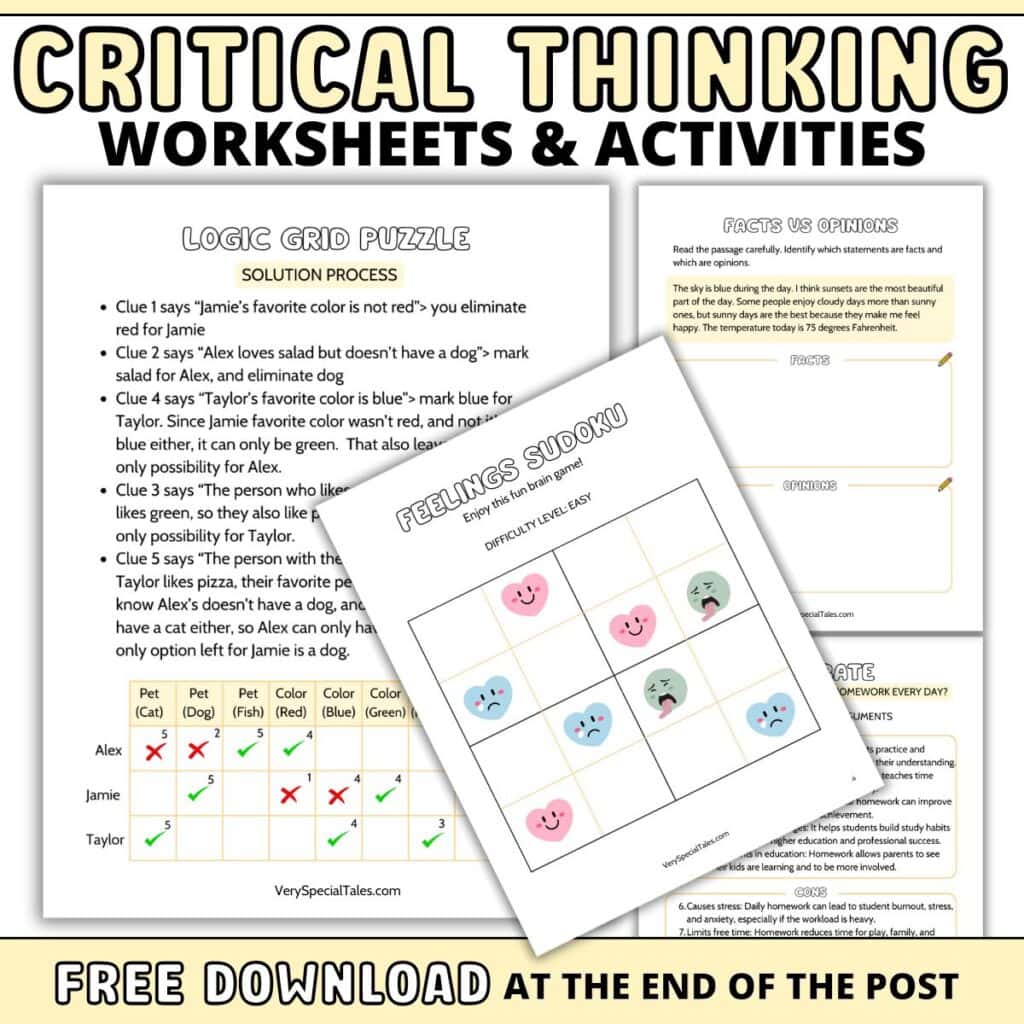
36 Fun Critical Thinking Games and Activities for Kids
Now that we have reflected on what critical thinking is and why it is so important for cognitive development, let’s jump in and start practicing a whole set of engaging and fun activities to help children strengthen these skills and develop a critical thinking mindset.
These activities can be used as building blocks and inspiration, in the classroom and at home. They can be woven in to wider learning, or used as creative ideas to have family conversations at the dinner table.
Fun Simple Critical Thinking Activities for Kids
1. Sorting Objects
Strengthen logical reasoning by encouraging kids to classify items based on attributes like size, color, or shape, helping them identify patterns and make connections.
For example, ask children to sort a group of buttons of different colors, sizes, and shapes, and then explain the reasoning behind their sorting criteria.
2. Count and Analyze Patterns
Use colored beads to create sequences (e.g., red, blue, red, blue) and ask children to predict what comes next, or to create their own repeating patterns.
3. Find the Odd One Out
Present a group of objects like a banana, an apple, a car, and ask children to identify which one is the odd one out and explain why.
4. Who Am I?
A child thinks of an object, and the others ask yes/no questions to figure it out, such as “Is it something you find outside?” or “Can you eat it?”
5. “What If?” Questions
This type of game encourages curiosity and deeper thinking by exploring open-ended questions, much like the Socratic method, encouraging students to reason and arrive at their own conclusions.
Ask children questions such as:
- What if animals could talk? How would that change our relationship with them?
- What if there were no rules? What do you think society would look like?
- What if everyone had the same job? How would our world look?
6. Story-building with Critical Questions
- Example : Build a short story with a problem, like “The dog is lost,” and ask children to discuss the cause, what steps can be taken to find the dog, and the potential outcomes.
7. Problem-Solving Storybooks
You can use your usual classroom activities and turn them into problem-solving activities. For example, if you’re reading a book like The Three Little Pigs , you can pause to ask, “What would have happened if the pigs had built their house differently?” This encourages kids to analyze decisions in the plot and think critically about alternative outcomes.
8. Reviewing Evidence (Detective Games)
Create a detective game where children review evidence (footprints, letters) to figure out “who ate the cookies” or another mystery, requiring logical deduction.
Critical Thinking Games & Brain-Teasers
9. Memory Card Games / Matching Card Games
Memory card games are classic games in which children flip over cards to find matching pairs.
Although memory games are more clearly associated with memory skills, they can also support critical thinking by encouraging attention to detail, pattern recognition, and strategic recall of card locations to match pairs efficiently.
For example, instead of flipping cards randomly, kids could start by lifting cards from left to right in each row. This structured approach can help them remember the sequence and location of cards, making it easier to spot matches when a similar card appears later. By developing this strategy, they’re not only improving their memory but also practicing critical thinking through planning and pattern recognition.
10. Scavenger Hunts
To turn a scavenger hunt into a critical thinking activity, add clues that require kids to solve puzzles, interpret riddles, or make inferences to find each item.
For example, instead of simply listing an umbrella, provide clues like “I’m something that keeps you dry in the rain, and you hold me above your head”. You could also add challenges where kids must categorize the items they find by characteristics (like color or texture) or answer questions about why each item might be useful in different situations.
This approach encourages problem-solving, inference, and categorization skills throughout the hunt.
11. Mystery Bag Game
A Mystery Bag game encourages kids to use their senses and deduction skills to identify hidden objects. Place various items in a bag and allow kids to feel each one without looking, prompting them to guess what it is based on texture, shape, or weight. They can ask yes-or-no questions to narrow down possibilities (e.g., “Is it soft?”, “Is it something I can eat? or “Is it something we use every day?”).This activity fosters critical thinking by requiring kids to analyze clues, make inferences, and refine their guesses, enhancing their problem-solving abilities.
12. Puzzle Solving
Puzzles can boost logical thinking and problem-solving skills by encouraging kids to find solutions through trial, error, and reasoning.
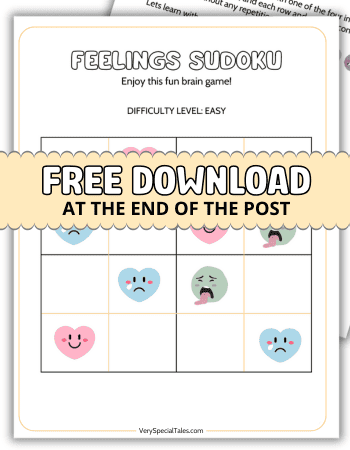
13. Sudoku (Simple)
Sudoku is another great puzzle game that promotes logic, pattern recognition, and problem-solving for children of all ages.
The game can be tailored to various skill levels, making it suitable for all ages: the easiest grids start with a 4×4 layout, perfect for younger kids who are just beginning to explore logical reasoning.
For a fun twist, you don’t even need to use numbers! Simple shapes or colors can replace numbers to create a kid-friendly version, allowing younger children to solve puzzles with familiar objects while developing their reasoning skills.
I’ve included a fun, simple Sudoku activity in your download at the end of this post that younger kids will love.
14. Mystery Number Games
Give a series of clues, like “I’m thinking of a number between 1 and 10, and it’s not even,” and have children ask questions to deduce the number.
15. Logic Riddles or Brain Teasers
Riddles and Puzzles are a fun way to present a mental challenge to kids. They are widely available in puzzle books and logic activity books for children.
Examples of riddles:
- “What has keys but can’t open locks?” and have children reason out the answer by thinking about the word “piano.”
- “I speak without a mouth and hear without ears. I have no body, but I come alive with the wind. What am I?” (this one is echo, in case you didn’t guess it)
16. Lateral Thinking Puzzles .
Lateral thinking puzzles are puzzles designed to challenge traditional thinking patterns by encouraging creative, outside-the-box solutions. Instead of straightforward logic, these puzzles require unconventional reasoning and unique perspectives, pushing kids to think beyond obvious answers.
For example, a lateral thinking puzzle might present a scenario where only by reinterpreting or reframing details can the solution be found, such as:
- “A man walks into a town on Friday, stays for three days, and leaves on Friday. How is this possible?”(Answer: The man’s horse is named Friday.)
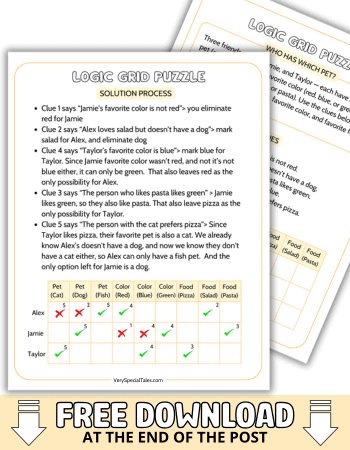
17. Logic Grid Puzzles
Logic grid puzzles are brain-teasers that involve filling in a grid based on a set of clues to determine relationships between different categories or items.
For instance, you might have a puzzle about three friends, each with a different pet, favorite color, and favorite food. Using the clues provided (e.g., “The person with the cat doesn’t like pizza”), you can eliminate possibilities and make connections until all categories align correctly.
These puzzles develop critical thinking and deductive reasoning skills, as solvers must analyze the clues, make inferences, and systematically rule out options to find the solution.
Your free Critical Thinking Worksheets download, at the end of this post, also includes an example of a logic grid puzzle.
18. Maze Challenges
Provide a printed maze and ask children to solve it by choosing the correct path, discussing their strategy for avoiding dead ends and reaching the goal.
Our next two activities are classic strategy games that promote strategic planning and evaluation:
Chess is a timeless game of strategy, widely available both digitally and physically in educational formats. Set up a chessboard and teach children the basic moves, then have them play a game where they practice planning several moves ahead, anticipating their opponent’s strategy.
20. Checkers
Checkers is another, simpler strategy board game. Play a simple game of checkers with a child, encouraging them to think one or two moves ahead to capture pieces and block their opponent.
21. Role-Playing Games
Role-playing games (RPGs) are games where players assume the roles of specific characters, often in a fictional or fantastical setting, and make decisions that shape the story or world around them. In RPGs, players use imagination and creativity to develop characters with unique abilities, personalities, and goals, often collaborating to solve challenges or quests.
There are different types of RPGs, such as:
- Tabletop RPGs (e.g., Dungeons & Dragons ), where players narrate actions and decisions guided by a game master.
- Live-action RPGs (LARPs) , where players physically act out their characters’ actions.
- Video Game RPGs (e.g., Final Fantasy , – although note that while previous editions have been mostly young teen-friendly, some editions are rated M / R13. For fully kid-friendly video RPGs, you check out Starport or Kids on Bikes.
RPGs, like tabletop and video game formats, can be safe and valuable for teaching critical thinking, teamwork, and creativity, with a few guidelines:
- Age-Appropriate Content : Choose RPGs with themes and language suitable for the classroom.
- Screen Time : Balance video game use with other activities to avoid excessive exposure.
- Safety in Live-Action : For LARPs, set clear boundaries to ensure a safe environment.
- Classroom-Friendly RPGs : No Thank You, Evil! and Rory’s Story Cubes promote storytelling and problem-solving.
- Educational RPGs : Classcraft uses RPG quests to support learning goals and teamwork.
- Simple Role-Playing Activities : Use history or science scenarios to bring content to life through role-play.
22. Escape Rooms
Participating in a escape room activity is an excellent way for older students to practice critical thinking skills. Participants are locked inside a themed room and must work together to solve puzzles, find clues, and accomplish tasks within a given time limit in order to “escape” from the room. Escape rooms are great team-building games and promote critical thinking through:
- Problem-Solving : Players must analyze clues, recognize patterns, and piece together information to advance.
- Logical Reasoning : Each puzzle builds on the next, requiring logical deduction to understand how clues relate.
- Analytical Skills : Players break down complex information, assess details carefully, and synthesize clues to solve each step
- Teamwork : Players need to communicate effectively, share ideas, and build on each other’s strengths to solve complex problems together.
- Time Management : The time constraint encourages quick thinking and prioritizing.
Let’s also explore some educational games and activities!
Critical Thinking Activities for the Classroom
23. Improvised Building Activity (STEM – Science Activity )
Provide children with a box of mixed-up items like straws, paper clips, and rubber bands, and ask them to build a structure that can hold a small toy car, encouraging problem-solving.
24. Guess the Cause and Effect / Scientific Inquiry Activities
Engage kids to explore relationships by predicting outcomes, testing hypotheses, and observing results, strengthening their understanding of cause and effect through hands-on discovery.
Some cause-effect activity examples:
- Sink or Float : Have kids predict whether various objects (like a coin, sponge, or apple) will sink or float, then test each item in water and observe the outcomes.
- Plant Growth Experiment 1 : Plant seeds in different conditions (sunlight vs. darkness or water vs. no water) and have kids guess which plants will grow best, tracking progress over time.
- Plant Growth Experiment 2: Show kids a plant that’s wilting and ask, “What do you think is happening here?” Let them suggest reasons like “It needs water” or “It’s too sunny,” and then test their hypothesis.
- Ball Drop Test : Ask kids to predict which will bounce the highest, a tennis ball, basketball, or a bouncy ball. Then perform the experiment by dropping them from the same height, to see if their predictions were correct.
25. Simple Coding (Logic-Based)
Use a coding game like “Scratch Jr.” to have children sequence blocks to make a character move in a specific direction, reinforcing the concept of logic and order. Some examples of other coding apps for kids are Scratch, Code.org, or Tynker.

26. Facts vs. Opinion (Worksheet)
Fact vs. Opinion activities help kids learn to tell the difference between objective truths and personal viewpoints, which is essential for critical thinking. By distinguishing facts—things that can be proven true—from opinions, which reflect personal feelings or beliefs, kids become better at evaluating information.
These activities teach them to look for evidence, question sources and understand that not everything they hear or read is a fact, which is a valuable skill in everyday decision-making and understanding of the world around them.
You can download a simple Facts vs Opinion activity to add to your critical thinking classroom games at the end of this article.
27. Observation Journals
Observation Journals are a great critical thinking exercise, encouraging kids to record daily observations and reflect on details in their surroundings. This practice sharpens mindfulness, enhances analytical skills, and prompts kids to notice patterns, make connections, and express unique perspectives.
Observation journals can include prompts like, “What did you notice on your way to school?” or “Describe something interesting you saw today.”
This versatile activity can be used for nature walks, scientific observations, or even social settings, making it a fun and educational habit.
28. Simple Flowcharts
Simple Flowcharts are an excellent tool for helping kids visualize steps in a process, enhancing their problem-solving and critical thinking skills.
Creating flowcharts teaches them to break down tasks into manageable parts, understand sequences, make logical connections between actions, and practice decision-making. This exercise can be used for anything from illustrating everyday life routines to mapping out decision-making steps.
This is an example of what a flow chart for “deciding what to do after school” could look like:
- If Yes → Go to Step 2
- If No → Start Homework
- If Yes → Go to Step 3
- If No → Complete Chores
- If Yes → Go Outside
- If No → Go to Step 4
- If Read → Read Book
- If Game → Play Game
29. Problem Solving Activities
Give kids a problem (for example, “How do I fix this broken toy”, and ask them to evaluate different possible solutions, such as glue, tape, or replacing parts.)
Guide them through the problem-solving process:
- Identifying the problem (what has happened?)
- Analyzing the problem (how did it happen?)
- Generating potential solutions or strategies to address the problem.
- Evaluating all possible solutions (Pros and Cons Analysis)
- Selecting the best solution based on their analysis and judgment.
- Implementing the best solution
- Monitoring progress and results
- Reviewing and evaluating the outcomes and making adjustments if necessary.
Other resources: Problem-solving workbook for kids
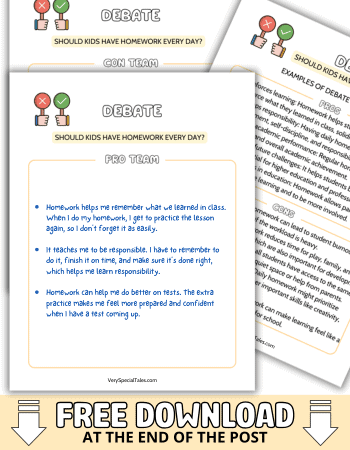
Debates are a fantastic way to encourage creative thinking and help kids understand different perspectives on real-world problems. By arguing for or against a topic, students learn to consider and respect diverse viewpoints, building skills in critical analysis and the curiosity and flexibility needed for problem-solving.
Divide students into groups, and randomly allocate the teams that will defend either position.
Here’s a list of five debate topics that would work well for a team pro/con structure:
- Should kids have homework every day?
- Would it be it better to have a longer summer break, or shorter school days year-round?
- Should schools ban junk food from the cafeteria?
- Is it better to learn from books or through technology?
- Should animals be kept in zoos?
- Should kids be allowed to have smartphones?
31. Classification Game
Present a set of mixed-up objects (e.g., animals, plants, objects) and ask children to categorize them into specific groups (e.g., mammals, plants, machines).
32. Predicting Changes in an Ecosystem
This activity involves analyzing data or observing patterns to make educated guesses about how an ecosystem might evolve under certain conditions. This can help students understand cause and effect within natural systems, fostering critical thinking about environmental science and ecology.
For example, create a small ecosystem using plants and animals (real or artificial) and ask children what would happen if a new element was introduced, such as removing one species or adding a new one. ed: suggest plants and insects. Creating an ecosystem with animals is a big ask!
33. Making Predictions from Data
Making Predictions from Data is a real-world activity that teaches students to analyze patterns and trends to make informed guesses about future outcomes. By examining data, whether from a simple weather chart or a survey on favorite foods, students learn to interpret information, identify trends, and develop critical thinking skills. This activity can be used in various subjects, helping students understand how data supports decision-making in everyday life.
For example, give students data on the number of books read by their classmates each month. They notice that book reading increased steadily from September to December. Based on this trend, ask them to predict how many books will be read in January and discuss possible reasons for the increase, like cooler weather or reading challenges.
34. Comparing and Contrasting Items
Comparing and Contrasting is a key critical thinking activity that helps students explore similarities and differences between topics, ideas, or items. This skill can be applied to anything from everyday choices to analyzing historical events, comparing characters in a story, or understanding scientific concepts. An effective activity is to have students compare items they might want to buy, like two different backpacks or tablets. By evaluating features, prices, and quality, they practice making informed decisions, building both analytical and decision-making skills.
35. Analyze a News Article
Provide a simple news article on current affairs and ask children to identify the key points of that particular situation, evaluate the reliability of the sources, and discuss what actions they might take if they were involved in the situation. This activity builds critical thinking by encouraging them to reflect on real-world events and consider different perspectives.
36. Make a Decision Matrix
A Decision Matrix is a tool that helps students evaluate multiple options by rating each one based on specific criteria. It’s a grid where options are listed on one side, criteria on the other, and each option is scored to find the best choice. This encourages critical thinking and teaches students to make thoughtful, balanced decisions by considering all aspects of a problem.
- Students are deciding on a class project, they can list options (like a science experiment, art display, or community service) and criteria (interest level, resources needed, time required) to help choose the best fit.
- Families choosing a pet may weigh options like size, cost, care requirements, and activity level.
Incorporating critical thinking activities in the classroom is a powerful way to nurture young minds. These exercises build essential cognitive skills and help kids become inquisitive, confident thinkers.
Other Cognitive Abilities Resources & Articles
- Fun Problem-Solving Workbook for Kids
- 25 Problem-Solving Activities for Kids
- 57 Memory Activities for Kids
- 30 Focus & Attention Activities for Kids
Critical Thinking Worksheets for Kids (PDF Download)
Your critical thinking worksheets include the following activities:
- Fun Shapes Sudoku
- Fact vs Opinion
- Debate Activity

Leave a Reply Cancel reply
Your email address will not be published. Required fields are marked *

COMMENTS
These Critical Thinking Activities Task Cards provide teachers with activities and puzzles to help students develop critical thinking skills. In this pack, you will find 80 quick start task cards – 4 cards per page. Your elementary students will love trying to figure out the puzzle or challenge and you will love knowing that they are using ...
Puzzles and Brain Teasers - Full List. Addition Squares. Build logical thinking skills with these addition square puzzles. Brain Teasers. Challenge students with these mind-bending, critical thinking puzzles. Cipher Wheels: Secret Code Facts. Assemble a cipher disk and use it to decode facts about animals, explorers, plants, and other science ...
With the barrage of mainstream news, advertising, and social media content out there, it’s vital for students to think independently and learn to differentiate between fact and fiction. This series of critical thinking activities, STEM-based design challenges, engaging Math puzzles, and problem-solving tasks will support students in thinking rationally and understanding the logical ...
We have seen that critical thinking is about both skills and mindset. The best way to support critical thinking is to work on both acquiring the skills necessary for critical thinking (e.g. analysis, inference, evaluation, self-regulation), and encouraging the attitudes needed to think critically (e.g. being open minded, fair minded, and curious).
This arrangement will help you and your students more clearly understand and identify the specific critical-thinking skills they are using. For each thinking skill in this book, there are two kinds of activities: (1) those that you, as the teacher, will lead, and (2) student reproducibles for indepen-dent work.
Little Alchemy 2. Flex alchemical muscles in amusing, discovery-based puzzler. Bottom Line: This amusing puzzle game encourages creativity, perseverance, and systems thinking, and with creative integration it can build interest in math, science, history, and literature. Grades: 6–12. Price: